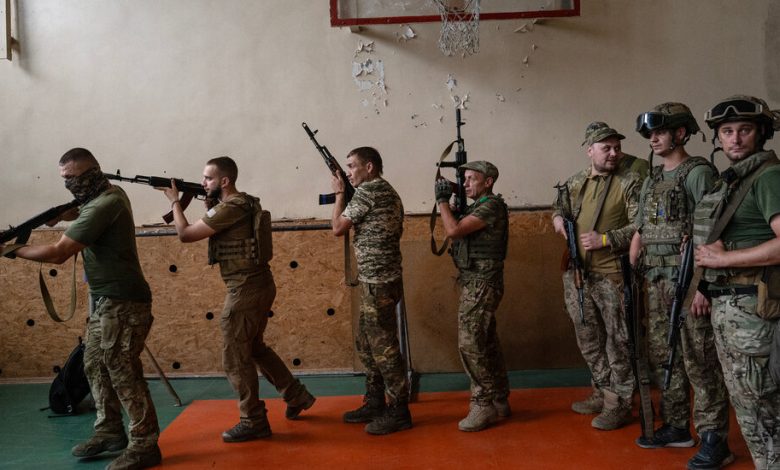Inside Biden’s Reversal on Sending Long-Range Missiles to Ukraine

From the opening days of the war in Ukraine, President Volodymyr Zelensky told President Biden there was one weapon he needed above all others: Long-range missiles, known as ATACMS, that could reach air bases and Russian troops more than 100 miles behind the lines.
For the better part of 18 months, Mr. Biden had one response, both publicly and in his sometimes tense private meetings with Mr. Zelensky: No.
The weapons, he said, could cross one of the “red lines” of President Vladimir V. Putin of Russia, a possibility the president had to take seriously since Mr. Putin was episodically threatening to unleash tactical nuclear weapons.
After blasts at two air bases in Russian-held territory in southern and eastern Ukraine on Tuesday, it became clear that Mr. Biden had changed his mind, again. Amid the wreckage of Russian helicopters, there was evidence that the bases had been struck by American-supplied ATACMS — Army Tactical Missile Systems — that were the last big unfulfilled ask from Mr. Zelensky.
The story of how that happened, as described by several administration officials, is more complex than a caricature circulating in Washington that Mr. Biden is cautious to a fault, and says no until the pressure is insurmountable.
In this case, there was plenty of pressure. Some came from members of Congress, including Representative Jason Crow, a Colorado Democrat and former Army Ranger, who wrote to the White House that Ukraine needed weapons “to target deep supply lines and Russian command and control centers.” Mr. Crow added that while systems already provided to Ukraine were being used “to devastating effect,” the Russians “have adapted to ensure key assets are outside their range.”
A push also came from Mr. Zelensky at the NATO summit in Vilnius in July, when the Ukrainian leader made no secret of his anger that Mr. Biden and Chancellor Olaf Scholz of Germany had blocked any clear statement that Ukraine was on a path to NATO membership.
With a touch of bitterness, he told reporters “there is no decision” from Mr. Biden on the issue of ATACMS, and he added: “It is better not to raise the issue because there are expectations of the people, the military, everyone.” It would be better, he said, “to do it first, and then share information on how it happened.”
But officials in the White House insist that it runs a vigorous review process to make sure that weapons meet needs. In July, Mr. Biden’s aides said, they came to see what one called a “clear use case” for ATACMS. It was the one Mr. Crow had identified, using the ATACMS to target supply lines and air bases that Ukraine could not reach. At a July 14 meeting in the office of Jake Sullivan, the president’s national security adviser, he and Jon Finer, his primary deputy, talked with a small group of officials about developing options.
The study came at a moment of division in the Biden administration. Secretary of State Antony J. Blinken had long been pressing for giving the Ukrainians more weapons sooner. Otherwise, Mr. Blinken said, the United States looked reluctant to give aid, and reactive. In public, he was more discrete, saying only he was “forward leaning” on arming Ukraine.
Defense Secretary Lloyd J. Austin III took the other side. The United States had a limited supply of ATACMs, and turning them over the Ukrainians, who were running through ammunition at a much faster clip than needed, would leave the United States and its allies vulnerable. Readiness is not just a word, Mr. Austin argued, it is a necessity.
There was also a budget issue. The White House was running down more than $40 billion Congress had allocated for military help to Ukraine, and a growing number of Republicans were objecting to more spending. ATACMS were not cheap, about $1.5 million each.
By September, the group Mr. Sullivan and Mr. Finer organized came back with an analysis and a proposal. Escalation no longer seemed a major issue, they concluded. Britain had started supplying its Storm Shadow missiles in June, with ranges approaching the ATACMS, and Mr. Putin barely reacted.
The helicopters and other aircraft that the Russians were lining up on occupied territory, usually at airports, were targets. At meetings, Mr. Austin agreed because the version of the ATACMS under discussion had a range of only 100 miles and were armed with cluster munitions that spread out to do maximum damage to unprotected targets like the aircraft.
Cluster munitions are banned by an international convention because “duds” left on the ground can injure civilians, often children, who pick them up. The United States has never ratified the convention, but would be highly unlikely to use the weapons. In July, the United States sent other types of cluster munitions to Ukraine, drawing widespread condemnation.
The ATACMS proposal was embraced by other administration officials, and Mr. Biden agreed. He told Mr. Zelensky when they met in Washington last month, but they agreed not to announce the decision.
It leaked out, but the timing of the shipments remained secret, part of an effort to take the Russians by surprise, before they had time to move their helicopters out of range. Which is what appears to have happened on Tuesday.





